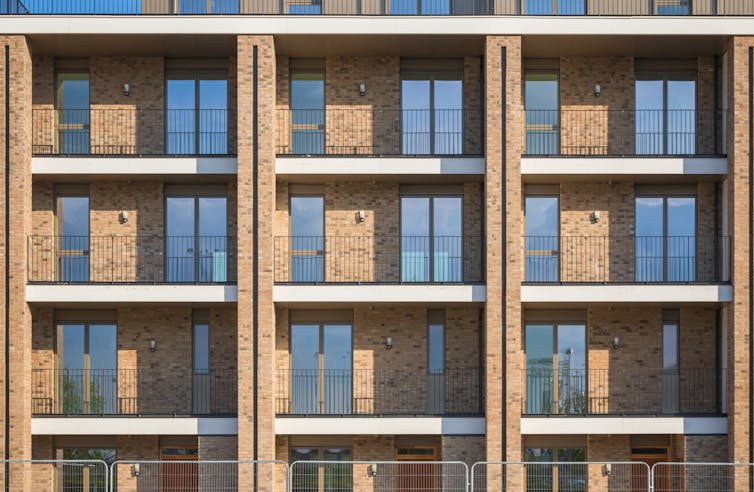Not long after the global financial crisis, soaring house prices through the 2010s turned residential property into the largest capital asset and best long-term investment in the world. In the same period, rates of owner-occupation fell across the UK, US and Australia. Now, for the first time in 50 years, a growing proportion of households in these countries rent.
Some households in every age group have dropped out of ownership because of unsustainable costs and risks, but the young in particular are being priced out as the sector shrinks. In the UK, ownership rates among 25-34 year-olds halved to 30% in less than two decades.
It feels like the end of an era. Experts are already talking about “post-homeownership”, with private renting as the go-to alternative – even in the UK, where social (council) housing once played such a central role.
The long-awaited renters’ reform bill promises to improve conditions for renters, primarily by getting rid of no-fault evictions. But this won’t do enough to fix the problem of declining supply and quality, or rising prices, that are defining the private rented sector today.
The UK private rental sector has doubled in size since the mid-1990s, and accommodates around 4.5 million (one in five) households. It has not, however, done so well in terms of housing quality, supply and cost.
Private renting has traditionally been the province of the young and mobile: even today two-fifths of tenants are under 35. Yet, compared with 20 years ago, private renters are now older, on lower incomes, and more likely to be living with children. The sector may have expanded but it has not adjusted to the needs of this new demographic.
Furthermore, one third of privately rented homes were built before 1919, and a quarter now fall below the government’s “decent homes” threshold. The over-55s with few savings or investments, who are vulnerable to fuel poverty, live disproportionately in these properties. The private rental sector also shelters 1.6 million children, often in homes that are damp, mouldy, excessively cold, overcrowded and with the least security of tenure.
Supply and demand
As well as the challenge of quality and condition, there is the matter of supply. Britain’s private rental sector is dominated by small landlords drawn into the post-1990 buy-to-let boom. However, tax and regulatory changes have curbed that trend, and one third of these landlords now plan to sell or reduce the size of their portfolios.
With demand for tenancies also rising, rental listings have fallen by 40% against pre-pandemic norms, causing mayhem on the market, with long queues to view and bidding wars adding to costs.
Europe-wide rent increases, affecting every demographic, are particularly marked in the UK, growing by nearly 17% in the eight years to December 2022. The latest hike (4.2% to the end of last year) was the largest since the Office for National Statistics launched its rental price index in 2016.
Private renters now spend a higher proportion of their incomes on housing than any other tenure group. One in four are struggling to pay, and two thirds of the over-65s are cutting back on essentials.
Reviving the private rental sector
There is growing dissatisfaction with the quality, cost, supply and management of private rental housing. As small landlords scale back, therefore, all eyes are on the growth of large corporate landlords whose expanding property portfolios are proving attractive to institutional investors like pension funds, listed property companies and residential real estate investment trusts.
Corporate landlords aim to professionalise and grow the sector, eventually, perhaps, through bulk buy-to-let. But the current trend is build-to-rent, which promises to couple socially and environmentally responsible investment with stable rental returns and long-run capital gains.
This style of renting appeals particularly to young, higher earners who are locked out of ownership by high deposit requirements – “rental prisoners” who can afford to pay a premium to bundle accommodation with hotel-style amenities and services. Others are not so fortunate.
This is, moreover, no quick fix for supply. At best, build-to-rent will account for 8% of the private rented sector by the early 2030s. Neither is there good news on affordability. In North America, large (global) corporate landlords have been scaling up their portfolios by raising rents, fees and ancillary revenues as well as by growing supply. Concerns have also been raised in the UK, while Berliners voted decisively against this corporate model.

What’s next?
If private renting can’t compensate for the retreat of owner occupation, is there anything more imaginative on the table?
One must-have is investment in social housing, which the UK championed a generation ago. Reinvigorating the vision and values that drove that movement is surely the only way to address the present crisis of homelessness and affordability. More generally, the idea of housing according to need, rather than just ability to pay, is attracting renewed enthusiasm across the OECD.
Second, small landlords are struggling with costs and regulatory changes. Why not incentivise them to sell to not-for-profit providers, diversifying and enlarging an important community-based housing movement? If corporates also earmarked more of their portfolios for affordability, there could be a further opportunity to reform rental housing in a way that prioritises tenant wellbeing and support.
Both government and opposition, on the other hand, have their sights on a new “generation buy”. To this end, one bank has already reintroduced 100% mortgages. But old-style home ownership has probably had its day. A rethink is long overdue.
What if, for example, a fraction of house price appreciation were top-sliced and used to maintain, decarbonise and future-proof the housing stock? What if homeowners were positioned as the temporary occupants of properties built for stewardship rather than possession? Shifts like this could be funded by reforming housing’s incoherent tax position, itself an important step towards a fairer, more inclusive future.
Read more: Rent or buy: does the British obsession with home ownership pay off?

